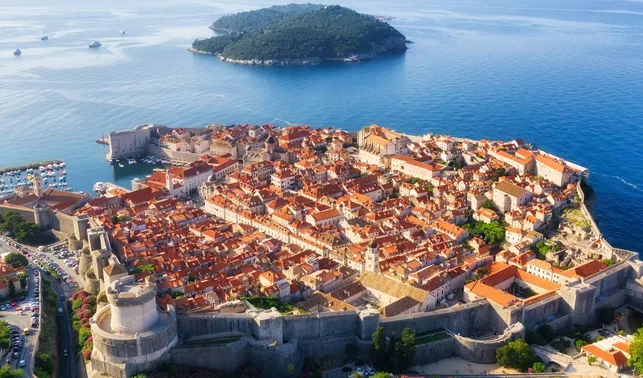Hidden Balkan with Greece


Trip Overview
Start in Belgrade and end in Athens! With the In-depth Cultural tour Hidden Balkan with Greece, you have a 15 days tour package taking you through Belgrade, Serbia and 21 other destinations in Europe. Hidden Balkan with Greece includes accommodation in a hotel, meals, transport and more.
- Chauffeur
- 6 Countries
- 15 Days
- 14 Nights
- Meals
Trip itinerary
Upon arrival in Belgrade, the capital of Serbia, you will be welcomed by your driver and escorted to your hotel. On the short coach ride from the Nikola Tesla airport, sit back, relax and enjoy the sights of New Belgrade with its prominent ‘blocks’ – a classic example of Socialist architecture, built after World War II – and modern business centres, including the imposing Ušće Tower. Along the way, your driver will show you and tell some stories about the Western Gate of Belgrade, the famous Belgrade Arena and the monumental Palace of Serbia. Check-in at your hotel.
Use your free time to rest and prepare for the trip. At 7pm in the hotel reception, you will be greeted by your guide who will introduce himself and provide you with detailed information about the entire trip. For the rest of the evening, we recommend you take a short, leisurely walk through one of the oldest quarters towards the bohemian heart of Belgrade - Skadarlija. In a charming 19th century cobbled street you will find many numerous ‘kafanas’ where you can try delicious local specialties while listening to traditional music. Overnight.
Breakfast. On this tour, you will explore the most interesting sights of Vojvodina, a province in the north of Serbia. You will be driven through picturesque scenery and Serbia’s famous wine region towards the ‘Serbian Holy Land’, home to 17 functioning Serbian Orthodox monasteries. You will visit well preserved monastery Krušedol, where you’ll have the opportunity to buy wine and rakija made by the monks.
The tour continues on to town of Sremski Karlovci. A real gem of Serbian culture and spirituality, Sremski Karlovci feels like a ‘museum town’ with its Baroque centre, the Patriarchal Court, the Orthodox Cathedral of Saint Nicholas and the first Serbian secondary school (gymnasium). It is also famous for wine production and the town’s annual Wineball festival. You will finish your tour of this charming town with a visit and wine tasting at one the region’s most prominent wineries.
Further on the tour, you will visit the 2021 European Capital of Culture, Novi Sad. Located on the historical border of two former empires – the Austro-Hungarian and Ottoman – as a result, the capital of Vojvodina is a multi-cultural city with an interesting mix of architectural influences. On a sightseeing tour around the city, you will walk around the city’s pedestrian zone, past the City Hall, a Catholic church, the old city centre, the former house of Albert Einstein’s wife Mileva, the cultural foundation Matica Srpska and a synagogue. Then you’ll follow the right bank of Danube and visit Petrovaradin, or the so-called ‘Danube’s Gibraltar’, where the fortress is located. Drive back to Belgrade. Overnight.
After breakfast, you will embark on a tour (driving and walking) around Belgrade, a capital city well known for its various architectural styles, dynamic history and fantastic views of one of the biggest river confluences in the whole of Europe. Start the tour visiting the Museum of Yugoslav History, a memorial complex devoted to the life and deeds of Josip Broz Tito, the political leader of Yugoslavia. Next, you will pass by the stadium of FC Red Star – the former European and World Cup champions, and proceed to the Temple of Saint Sava, Belgrade’s patron saint. Very much a symbol of the city, this impressive building can be seen from any part of the capital.
After a short break at the Temple’s plateau, the panoramic tour will then take you from Slavija Square, to Saint Mark’s Church, the Serbian National Parliament and White Palace, and on to Republic Square. This most central point of Belgrade is surrounded by such cultural institutions as the National Theatre and National Museum. The tour will then head along the lively Knez Mihailo Street, the main pedestrian and shopping zone, before stopping for a visit to the Orthodox Cathedral Church of Saint Michael the Archangel, which is located just across from the Building of Patriarchate. Your guide will tell you about the tavern around the corner, the oldest in the city and intriguingly known as “?” (Question Mark), before continuing on to Kalemegdan Park and Belgrade Fortress, the most important cultural-historic complex of the city, situated on the confluence of the rivers Sava and Danube.
Breakfast and check-out. Morning departure from Belgrade, heading west towards the picturesque Ovčar-Kablar Gorge, through which the West Morava River meanders. The tour will continue on to Tara National Park, and you will have time to reflect on its beauty from aboard the authentic, retro ‘Nostalgia’ train which runs along the narrow-gauge heritage railway, Šargan Eight.
Travelling from the bottom of Šargan mountain on route shaped like the number eight (hence the name), you will be transported back in time while enjoying the stunning mountain scenery and numerous tunnels and viaducts. At the beginning of the 20th century, the railway used to be a part of the railway from Belgrade to Sarajevo. After enjoying the breathtaking nature, you will arrive at the ethno village Drvengrad (Wooden Town), built by prominent movie director Emir Kusturica. The village, which includes the Mećavnik Hotel, houses, galleries, shops, a cinema and a church, is made of natural materials, mostly wood. Since 2008, the village plays host to the annual Küstendorf Film and Music Festival and Drvengrad has been visited by the likes of Johnny Depp, Monica Belucci, Jim Jarmusch and many others.
After exploring Drvengrad, there will be a short drive to the famous Zlatibor Mountain, home of the first royal resort in Serbia. Here you can enjoy a relaxing walk around the quaint town centre of this picturesque air spa. In the evening, an enjoyable dinner of traditional Serbian food typical of the region will be served in the hotel.
Breakfast and check-out. The tour continues to Bosnia and Herzegovina and a short drive takes you to Višegrad, where Emir Kusturica used his imagination and creativity to build Andrićgrad (also known as Stone Town). It is a cultural centre with numerous buildings and facilities built on the banks of the Drina River near the famous bridge (a monument under the protection of UNESCO). The bridge is referenced in the title of Ivo Andrić’s novel The Bridge on the Drina and in honour of the Nobel Prize winning author, Kusturica’s town was called Andrićgrad (literally translated as Andrić’s Town). In Andrićgrad, the tour will stop for lunch at an unusual restaurant called Zlatna Moruna, the interior of which is decorated with frescoes by well-known artist Bisenija Tereščenko.
After lunch, the tour will continue on to Sarajevo, the capital of Bosnia and Herzegovina. Check-in at the hotel. After a short rest, the Sarajevo sightseeing tour will start, covering all the main sights including: Vijećnica or Sarajevo City Hall, the building of which was finished during the Austro-Hungarian period; the old downtown of the city called Baščaršija; the historical and cultural centre of Sarajevo with authentic shops and souqs from the Ottoman era; the Orthodox Church from the 16th century; the Gazi Husrev-bey mosque; the Sahat Tower from the 17th century; and the first public toilet in Europe. Next you will head on to the Latin Bridge where Gavrilo Princip shot the successor to the Austro-Hungarian throne Franz Ferdinand, consequently starting the First World War.
After crossing the bridge, you will reach Bezistan, a market complex from the 16th century, and then on to the main pedestrian zone Ferhadiya with the Sarajevo Synagogue from 1580 and a Catholic cathedral from 1881. Return to the hotel and overnight.
Breakfast and check-out. Drive to one of the most beautiful cities of the Balkan Peninsula, Mostar. During the walking tour, you will visit the symbol of the city, Balkan TOP 10 and the most photographed sight in the country – the Old Bridge (a UNESCO protected landmark). You will then proceed to Koski Mehmed Pasha Mosque, the Crooked Bridge and the old tanner’s quarter Tabhana. Free time in Mostar for getting lunch on the banks of the Neretva River, with an amazing view of the bridge that rises above you.
The excursion continues to Blagaj (a site on the UNESCO Tentative List), an old town from the 15th century where the Kosača noble family ruled. Blagaj was also the crib of Islam of today’s Bosnia and Herzegovina, when dervish Sari Satluk built a khanqah at the riverhead of Buna. During the short tour, enjoy the view of the monastery located in a fairy-tale environment, beneath the cliffs, on the shores of the emerald green river Buna.
The next destination of the day is Trebinje, a picturesque town with a wonderful mix of sights originating from a mix of different cultures. The tour starts with a visit to Arslanagića Bridge, a dream for artists and photographers alike; this stone bridge with its peaceful atmosphere will take you 400 years back in time. During the leisurely walk through the narrow streets of the old town, you’ll see the most important sights of Trebinje as you make your way to the so called ‘Poet’s Square’ where you can sit under the 115 year old trees, which are the symbol of the town. In this beautiful town, Emir Kusturica, the world famous movie director, made one of his last movies, with Monica Belluci in the leading role. Overnight in the hotel.
Breakfast and check – out. Drive and arrival in Dubrovnik, one of the most significant monuments in the world and one of Europe's best preserved walled cities, known since the 7th century. The old town is surrounded by a 2 km long wall that gives a great opportunity to see old Dubrovnik from above during a one hour relaxing walk; the city’s churches, fortifications and monuments are a real must-see. Dubrovnik has enchanted a lot of famous persons to devote their pieces of art to the city, thus in this city of marble and light coloured stone, you will find numerous art galleries and unique shops. In the historical centre of Dubrovnik, you will visit the main street Stradun, the main square Placa, Pile Gate, the Rector’s Palace, Sponza Palace, the walls of the Old Town, the church of Saint Blaise, the cathedral, the Jesuit church, Orlando’s Column, Big Onofrio’s Fountain, the city port and other hidden gems.
Drive to Budva, the town known as the tourist capital of Montenegro and for all the right reasons. Highlights include walk through the mediaeval cobbled streets of Budva's Old Town, a cocktail on the warm sandy beach and incredible views of the natural beauty of Budva, the bay and neighbouring islands. Located on a small peninsula, the Old Town represents a treasure chest of cultural heritage. Along the narrow streets and around the squares you will find famous buildings such as the Church of the Holy Trinity, which houses the tomb of the exquisite writer Stjepan Mitrov Ljubiša, and the churches of Saint Ivan, Santa Maria in Punta and Saint Sava. At the end of the tour, you will have some free time and we suggest using it to enjoy some fresh seafood and local wines at one of the many restaurants. Check–in to the hotel. Overnight.
Breakfast. Today you will head to the Bay of Kotor. With its unique landscape, it is a must-see location for more than 500 cruisers during a year. Our first stop a stop will be at the town of Perast, little settlement in baroque style. From Perast you’ll start a relaxing boat ride along Boka Kotorska Bay to picturesque island of Our Lady of the Rock. This manmade Island hosts a church with valuable paintings of local artists, silver votive tablets and a famous votive tapestry.
After the boat ride, you will continue to Kotor, an old Mediterranean town that dates back to the 12th and 14th century. A walking tour will allow you to explore this UNESCO site, including the churches of Saint Nicholas and Saint Luke, the Cathedral of Saint Tryphon and other cultural moments. You will have free time to continue wandering around the old paved town, or have lunch in a restaurant on one of romantic squares.
Back to Budva and free time for individual activities and enjoying in modern Mediterranean town. Overnight.
Breakfast and check-out. The tour continues through pristine nature, a national park and past Lake Skadar, the largest lake in Southern Europe. The Albanian spirit is best felt by visiting charming town of Shkodër, one of the oldest towns in Europe, unique by its narrow streets, stone walls and ancient houses. At the entrance of the town, the tour will start with a visit to the remains of the Venetian fortress Rozafa, one of the biggest and most famous castles in Albania. It rises imposingly on a rocky hill, surrounded by the Buna and Drina rivers, and offers amazing views of Shkodër, Lake Skadar and its water-intersected surroundings. Continue on the tour to the centre of the town, walking through the well preserved and most popular pedestrian street Kole Idromeno towards the other sights of the town, including the Ebu Bekr Mosque, the Orthodox Cathedral of the Nativity and the monument of Mother Teresa.
Drive to Tirana, the capital city of Albania as well as its largest city. Situated on the banks of the Lana River, Tirana has outstanding architecture, wide boulevards, parks, shops and cafés. The heart of Tirana is the Skanderbeg Square, where you will find many important ministry buildings, as well as the National Opera, the National Bank and the National Library. The square is dominated by a statue of Lord Skanderbeg, an Albanian hero and symbol of freedom and independence. During the sightseeing tour, you will be introduced to the architecture of the Mussolini period and see the city’s most important landmarks, including the Et'hem Bey Mosque, the National Museum of History, the Clock Tower and the Presidential Palace. As you stroll through the central part of the city, you can enjoy the many murals and works of art painted on the buildings by various artists and understand why Tirana is known as ‘the city of colourful buildings’.
Check-in to the hotel. Overnight.
Breakfast and check-out. On the way to North Macedonia, we will make a stop in Elbasan, the third largest city in Albania, located on the Shkumbin River. While the city was the main centre of Albanian nationalism during Ottoman rule, Elbasan is best known for its castle district. Here you can still admire the old city walls built by the Ottoman sultan Mehmet II on the ruins of the Roman and Byzantine fortifications, which gave the city the name of Eli-Bashan (“I put the hand”). Inside the fortress, while walking the cobblestone streets past old houses and excellent restaurants, you will see the Royal Mosque that dates back to the 15th century, the Orthodox Church of Saint Mary and the Sahati Clock Tower.
Continue to Ohrid, the soul of the Balkans and the cradle of Slavic literacy. Thanks to its extraordinary natural beauty and rich historical and cultural heritage, Ohrid was proclaimed as both a Cultural and Natural World Heritage Site by UNESCO. One of the oldest lakes in the world will welcome you with a photographic setting, impeccably clear water that reflects the lake’s picturesque high mountain surroundings. This former capital of the First Bulgarian Empire is the spiritual and national centre of Northern Macedonia. In the same area where the first Slavic university was founded, you will have the chance to visit over 300 Orthodox churches and monasteries.
Drive to Skopje. Check-in to the hotel. Overnight.
Breakfast. The capital of North Macedonia, for a long time Skopje has been the meeting point of different nations and cultures in the heart of the Balkans. After an earthquake in 1963, Skopje was rebuilt and it is now a modern city with a population of almost one million. With its fortress, cultural and historical monuments, archaeological sites and the nearby Matka canyon, it is a very attractive tourist destination.
Start your sightseeing tour in the old part of city with a stroll through the narrow streets of the Old Bazaar, the biggest bazaar preserved in the Balkans today. With the 1500-year old Kale fortress perched above, listen to stories about the Sultan Murad Mosque and Daut Pasha Hamam before walking across the Stone Bridge, close by the Archaeological Museum of North Macedonia, towards Macedonia Square and its amazing fountain with the ‘Warrior on a Horse’ monument. In the newer and more modern part of the city, you will also see the Porta Macedonia, the Memorial House of Mother Teresa, the Art Bridge and numerous statues of prominent North Macedonian figures.
For the remainder of the day, we suggest you use your free time to rest in the hotel before heading out to experience the city’s nightlife. We recommend heading to Debar Maalo — an area famed for its restaurants — and trying numerous North Macedonian delicacies including shopska salad, ajvar (roasted red pepper spread), sarma (minced meat rolled in cabbage/vine leaves), tavče gravče (baked beans) and stuffed peppers. Back to the hotel. Overnight.
Breakfast and check-out. Drive to Thessaloniki, Greece’s second largest city and one of the oldest in Europe. For many tourists all over the world, Thessaloniki is the perfect destination for leisure tourism, with its quality museums, concerts and rich nightlife.
The main sights of Thessaloniki date back to the Roman and Byzantine times and include the Roman Arch of Galerius, the Monument of Rotunda, the Church of Saint Demetrius and the mediaeval castle Heptapyrgion. During the Thessaloniki city tour, you will visit Aristotelous Square, the city’s most central square and home to monumental mansions. It is one of the biggest and most impressive squares in Greece and offers a wonderful view of the Thermaic Gulf — with clear skies, you can see Mount Olympus in the distance. A walk along Nikis Avenue will take you along the coast, from the city’s port to the statue of Alexander the Great. Lined with many cafés, bars and stores, this avenue is one of the city’s most favoured places to walk for locals and visitors alike. Continuing on the tour, you certainly will not miss a visit to the White Tower, the most popular monument and a symbol of the city; the Arch of Galerius erected to commemorate the victory of the Roman Emperor Galerius over the Persians; the Rotunda which served as a mausoleum for Galerius and is now the Church of Saint George; and one of the oldest churches in city, the Church of Hagia Sofia, listed as a UNESCO World Heritage Site.
Use your free time in the evening to further explore this ancient city and afterwards, enjoy some local Mediterranean specialties and a glass of delicious Greek wine in one of the many restaurants overlooking the Bay of Thessaloniki. Overnight.
Breakfast and check-out. On the way to Athens, you will have a chance to visit the Meteora, a unique complex of Orthodox monasteries named after the Greek word for levitating stones. A place that, until 100 years ago, could only be reached by a rope net, today it is must-see location on a tour of Greece. Set on huge, steep cliffs, the monasteries evoke a mixture of awe and amazement, and it will come as no surprise that it is included on the UNESCO World Heritage List and considered as a unique cultural heritage phenomenon and one of the most important points on a cultural map of Greece. The stunning natural phenomenon of great geological age is also home to a resilient community of monks that inhabits six of the original 24 monasteries.
On the way to the Greek capital, enjoy the picturesque scenery of southern Greece, the part of Europe where the sun always shines. Check-in to the hotel. Free time to rest or to get out and catch the vibes of modern and vibrant capital. Overnight.
Breakfast. Start the day by exploring Athens, the capital of Greece, birthplace of democracy and home to the most important archaeological sites. The historic capital of Europe is best known for the Acropolis of Athens, the site of masterpieces of world architecture and art, among which the Parthenon — the greatest symbol of Ancient Greece and democracy — stands out.
As you explore the Acropolis, you will also see the Erechtheion, the Temple of Olympian Zeus and the world-famous sight Odeon of Herodes Atticus. Besides the Acropolis, the sights of this wonderful city not to be missed are the city's main central squares: Syntagma Square, at the foot of the Old Royal Palace, and Omonoia Square, where you will find some of the city’s most beautiful neoclassical buildings. On the sightseeing tour you will also visit the Panathenaic Stadium, where the first Olympic Games in modern history were held, as well as Monastiraki, a characteristic area of "old" Athens, with narrow streets and small buildings surrounding one of the oldest churches in Athens, the beautiful Church of Panagia Kapnikarea. No visit to Athens is complete without seeing the historic Plaka district, also known as the ‘Neighbourhood of the Gods’. With its tight, twisting alleys and colourful 19th century facades, this area is packed with small shops selling handmade souvenirs and local home-made food.
The afternoon is free for you to explore Athens on your own and discover the fashionable boutiques, sophisticated restaurants, cool bars and traditional taverns. Overnight.
Breakfast and hotel check-out. As most of our clients decide to extend their trip within their own organisation, transfer to the airport at the end of the tour is not included in the overall price. Any guests who would like Balkan&more to organise a departure transfer on their behalf are welcome to contact us. End of services.



